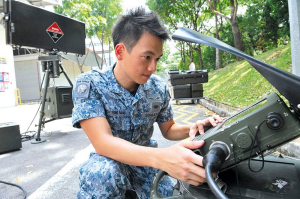OPS & TRAINING
BENEATH THE WINGS
05 Sep 2014

When people think of the Air Force, it's usually the pilots and fighter planes which come to mind. But behind them, there is a team of people working silently and tirelessly.
Sometimes, it's nice to shine the spotlight on those behind the scenes.
Beneath the "Above All" motto of the Republic of Singapore Air Force (RSAF) lies a crew of ground personnel who make up the majority of the Air Force. Among them are the Air Force Engineers (AFEs) from 9 Air Engineering and Logistics Group (9 AELG).
Formerly known as the Air Engineering and Logistics Squadron, 9 AELG was inaugurated in May this year, comprising two new squadrons - 809 Squadron (SQN) and 819 SQN.
"The newer generations of air defence systems are networked and utilise a wider range of technologies, so they require more expertise and a deeper understanding of the technologies to keep them running smoothly," said Military Expert (ME) 4-2 Kenneth Tang, Officer-in-Charge of Electro Mechanical Systems Flight from 819 SQN.
"The restructuring (to 9 AELG)allows us to make better use of our resources and time to build up our expertise (in maintenance and engineering) to keep our systems more reliable."
809 SQN focuses on providing day-to-day maintenance and immediate recovery of air defence systems, while 819 SQN resolves complex platform-level defects and prevents them from occurring again.
Maintaining day-to-day ops
"The primary role of the squadron is to recover these air defence assets such that we sustain 24/7 air defence operations," said ME 5-1 Edwin Leong.
The Officer Commanding of Integrated Maintenance Flight, Command and Control (C2) from 809 SQN explained that the squadron maintains a range of weapons, sensors and C2 systems.
Among them is the Portable Search and Target Acquisition Radar (PSTAR), which ME1-1 Yong Siang maintains.
On a regular basis, the 22-year-old conducts checks on the physical condition of the system to look for corrosion or loose cable connections, and also to check whether the system is functioning according to specifications. If he finds any faults, he has to fix them on the spot.
In-depth analytics
"Some defects can be fixed quickly, and they (809 SQN) can swop out the unserviceable item. For others, we would need to run more analytics to identify the fault. There are different components in each system and a fault could be caused by multiple components," said ME4-2 Tang.
He added that as engineers, 819 SQN's role was to study defect trends, assess if there are any reliability concerns and propose improvements.
For instance, ME1-1 Jolean Lim used to handle maintenance of the C2 systems, but now, as part of 819 SQN, she has to study and further analyse the system in order to fix complex faults and prevent them from happening again.
"We primarily work to recover the system immediately so that it does not affect operations. But later, we analyse the fault to find out the root cause of failure," said the 26-year-old.
Rising expectations
Since the inauguration of 9 AELG, the AFEs have had more time to focus on their designated field of expertise.
ME2-1 Ganesan, an AFE from 809 SQN, explained: "Now, my only aim is to maintain these systems and make sure that when my ops unit requires the system, it is serviceable for the mission. Each squadron can just focus on their respective roles."
Through taking up courses, making sure that the manuals they use are up to date and passing on knowledge to new AFEs, the 29-year-old ensures that no new system falls short of being operationally ready.
For 809 SQN, the challenge now is to rectify faults within a shorter time and get familiar with new systems faster. For 819 SQN, the challenge comes from learning new systems, such as the Surface-to-Air PYthon and DERby (SPYDER), from scratch. Explained ME4-2 Tang: "When we bought traditional systems, things were more established.
"Now that we're buying or coming up with new systems, it's uncharted territory and more difficult for us as there are no past lessons or experiences we can glean from."
More opportunities
Despite these challenges, the 28-year-old is happier. Having always had a passion for engineering, he enjoys being able to explore deeper issues and boost the reliability of the systems.
"The solutions that I implement will help the systems stay up for a longer period of time in the future," he said with a smile.
For ME1-1 Lim, working with more weapons is something that she is looking forward to, as she has always wanted to explore different systems and understand them better.
"There'll be lots of preparation. With every new system, we'll need to work closely with the manufacturer to understand all the nuts and bolts, so it's going to be busier. But it's very fulfilling because I know what I do helps to keep our air defence network intact and our skies safe."
ALSO READ IN OPS & TRAINING

Exercise Wallaby 2025: To see better, shoot faster
31 Oct 2025
The SAF focuses on complex strike missions and multi-domain integration in Exercise Wallaby 2025, the 35th edition of its largest unilateral overseas exercise.

Ex Wallaby 25 – Greater Integration and Complexity
25 Oct 2025
The 35th edition of the SAF’s largest unilateral overseas exercise is an opportunity for expanded scale and deeper integration towards an effective, networked fighting force.

Ex Forging Sabre ramps up use of unmanned assets in integrated strike operations
12 Sep 2025
In this 10th edition of Exercise Forging Sabre, the SAF sharpened its cutting edge for the dynamic modern battlefield, with expanded integration between manned and unmanned platforms.



